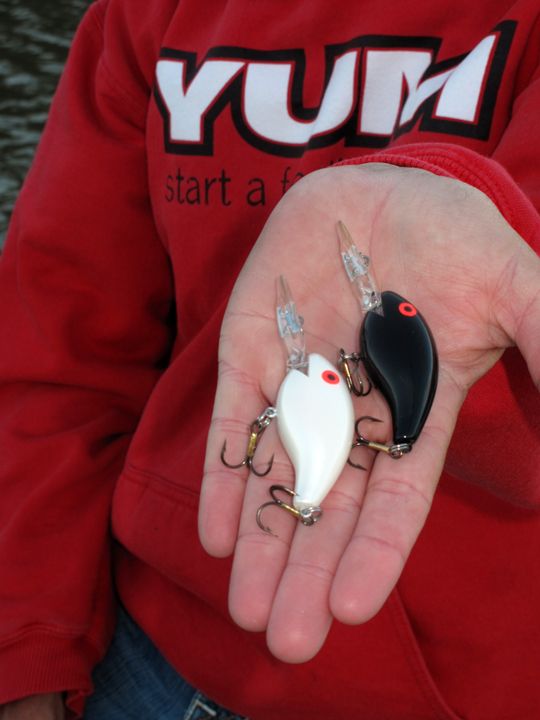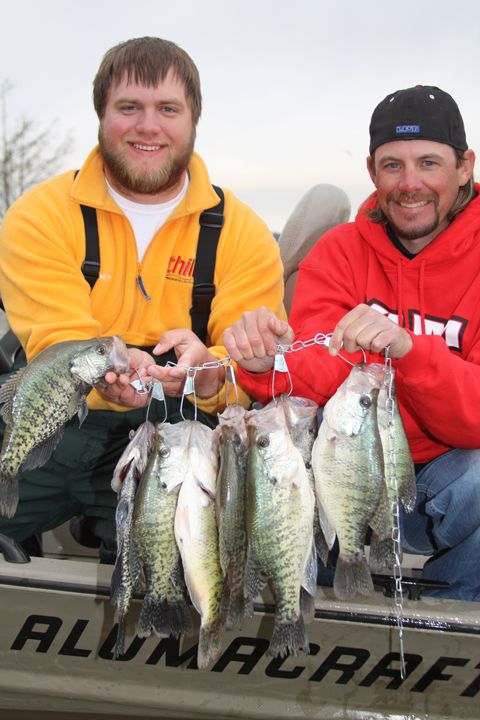 Summer was good, and you had the crappie pinned down. You could return to the same brushpiles or standing timber and pound limit after limit. But now comes the first cold front, and, where’d they go? Your hotspot is as desolate as a desert. While crappie don’t “migrate,” per se, they do scatter and spread out as water cools. This makes traditional slow techniques ineffective. During fall you need to take a more active approach.
Summer was good, and you had the crappie pinned down. You could return to the same brushpiles or standing timber and pound limit after limit. But now comes the first cold front, and, where’d they go? Your hotspot is as desolate as a desert. While crappie don’t “migrate,” per se, they do scatter and spread out as water cools. This makes traditional slow techniques ineffective. During fall you need to take a more active approach.
A Cranky Technique
In fall, the big schools of summer break up during fall and the fish spread out, often to areas where there is no obvious cover and nothing for you to key on. Trolling allows you to deliver baits to a lot of suspended fish in a short period of time, giving you good odds of triggering both hunger and reaction strikes from at least some of those fish.
 Trolling crankbaits has other advantages. It’s a good tactic in the wind because you are using more power and long lines absorb any rocking of the boat. Also, you can scout while trolling by watching the locator and marking GPS spots to try later with slower methods.
Trolling crankbaits has other advantages. It’s a good tactic in the wind because you are using more power and long lines absorb any rocking of the boat. Also, you can scout while trolling by watching the locator and marking GPS spots to try later with slower methods. Rigging Right
“There are two ways to rig for trolling,” says professional guide Todd Huckabee. “Two fishermen in a tournament will probably be using eight poles. You must set-up right with rod holders to make this method work. It’s not easy to keep all the baits separated and not getting tangled.”
Also, he says you’ll need a big supply of baits when pulling multiple poles so you can put different colors on each pole. Once the fish show a preference for one color you’ll want to put that color, or something with that color in it, on every pole.
Huckabee says, “My favorite colors in Mississippi seem to always be pink or black, while here in Oklahoma it’s chartreuse or white, or maybe chartreuse with a purple back. To my knowledge you can’t look at the water and know which crankbait color the crappie are going to hit. It just takes experience on a particular body of water along with test-fishing.”
Huckabee says that there are many baits on the market that will catch crappie but he sticks to his two favorites, the Bomber Fat Free Guppy and Crank-R.
“The Bomber Fat Free Guppy has always worked great for crappie and it use to be the only one I used. It’s designed to run 4- to 6-feet deep. Then came the Rebel Crank-R with an 8- to 12-foot rating making it easier to get deep. Also, each bait has a different action to give more choices when the fish are finicky. Both baits run true out of the box.”
The second setup Huckabee uses is to forget the pole holders, which take up room and are costly for the weekend fisherman. He says when guiding, each fisherman in his boat holds a pole. His clients enjoy feeling the strike. For recreational fisherman, it makes it easy to switch tactics for a while without worrying about a big setup change, installing rod holders, etc.
You need strong batteries and a trolling motor, or use your big outboard with a trolling plate. Huckabee prefers to keep it simple and use his trolling motor. Again, it lets him troll without making any major set-up changes, which is important for a guide who uses a variety of techniques.
A landing net is a necessity because a flopping fish and treble hooks are not a good combination. This is especially true when you get a white bass or a big catfish into the boat which is very common when trolling crankbaits.
Electronics is another requirement, but Huckabee says you don’t need the expensive stuff to do the job.
“I have a nice Humminbird setup. It helps find fish quickly but you’ll do fine with an inexpensive unit. However, you will need a GPS or other speed indicator. Your GPS can also be used to mark potential fishing spots to come back to later.”
Catching Crappie
“I set my speed to 1.5 mph and leave it,” says Huckabee. “Fishermen vary it from 1.3 to 1.8 but I set mine and leave it alone. Most of the time when fishermen aren’t getting bites it’s because they are going too slow. Speed is a constant with my trolling.”

He uses his own signature series 11-foot trolling rods and 10-pound test Silver Thread AN40. Long poles allow different positions to separate lines. No matter what setup you use be sure to keep lines separated to reduce tangled baits and lines.
“I like this technique because you can get in 12 foot or deeper water, just take off and cover as much water as possible. You’ll soon hit areas with concentrations of fish and you can make repeated passes through them. It’s a relaxing way to catch crappie and it’s something anyone can do.”
Good locations include big flats, points and channels. Big flats are the easiest to fish. Flats are popular with shad so it’s not unusual to hit big schools of them, which means you’ll likely find crappie swimming with them.”
Points are great crappie magnets. A trolling pass or two is all you need to determine if a point is holding active fish. Pay attention to your depth so you can repeat passes at the same depth and spot.
Channels can be good but very difficult to follow because they meander back and forth. The best tactic is to troll a straight line that will often intersect with the channel edges.
Final Tips:
>Trolling crankbaits is not without problems. The biggest is getting a treble hook stuck in you. Be careful. Protection like the Lindy Fish Handling Glove can help you safely handle fish and stop a hook from getting in your hand.
>A huge bonus to trolling is that you’ll catch many other species of fish. On a typical day it’s common to catch white bass, largemouth, catfish and rough fish.
>Anglers of any age can troll with just a little helping hand. Be sure to take the family so they can enjoy the fishing trip, too.
>A fouled crankbait will helicopter through the water making a mess of your lines. Always use a snap swivel when trolling.
